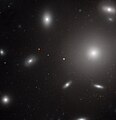NGC 4873
Appearance
| NGC 4873 | |
|---|---|
 SDSS image of NGC 4873. | |
| Observation data (J2000 epoch) | |
| Constellation | Coma Berenices |
| Right ascension | 12h 59m 32.8s[1] |
| Declination | 27° 59′ 01″[1] |
| Redshift | 0.019310/5789 km/s[1] |
| Distance | 269,276,000 ly |
| Group or cluster | Coma Cluster |
| Apparent magnitude (V) | 15.1[1] |
| Characteristics | |
| Type | SA0[1] |
| Size | ~79,000 ly (estimated) |
| Apparent size (V) | 0.67 x 0.45[1] |
| Other designations | |
| CGCG 160-229, DRCG 27-155, MCG 5-31-69, PGC 44621[1] | |
NGC 4873 is a lenticular galaxy located about 270 million light-years away[2] in the constellation of Coma Berenices.[3] NGC 4873 was discovered by astronomer Heinrich d'Arrest on May 10, 1863.[4] The galaxy is a member of the Coma Cluster.[5][6]
Other images
[edit]-
Map with labels of the galaxies in the central part of the Coma Cluster.
-
Hubble image of the giant galaxy NGC 4874. NGC 4873 is the small galaxy in upper-central portion of the image.
See also
[edit]References
[edit]- ^ a b c d e f g "NASA/IPAC Extragalactic Database". Results for NGC 4873. Retrieved 2017-09-14.
- ^ "Your NED Search Results". ned.ipac.caltech.edu. Retrieved 2017-09-15.
- ^ Rojas, Sebastián García. "Galaxy NGC 4873 - Lenticular Galaxy in Coma Berenices Constellation · Deep Sky Objects Browser". DSO Browser. Archived from the original on 2017-09-16. Retrieved 2017-09-15.
- ^ "New General Catalog Objects: NGC 4850 - 4899". cseligman.com. Retrieved 2017-09-15.
- ^ "Detailed Object Classifications". ned.ipac.caltech.edu. Retrieved 2017-09-15.
- ^ Steinicke, Wolfgang (2010-08-19). Observing and Cataloguing Nebulae and Star Clusters: From Herschel to Dreyer's New General Catalogue. Cambridge University Press. ISBN 978-1-139-49010-8.
External links
[edit]Wikimedia Commons has media related to NGC 4873.
- NGC 4873 on WikiSky: DSS2, SDSS, GALEX, IRAS, Hydrogen α, X-Ray, Astrophoto, Sky Map, Articles and images


